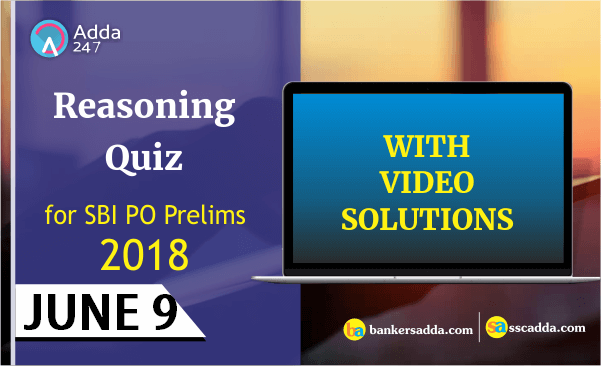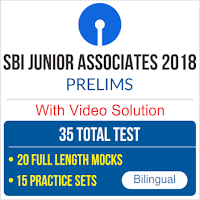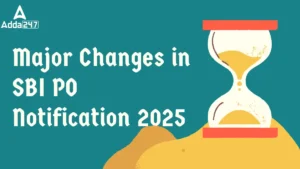Dear Aspirants,
Reasoning Questions for SBI PO Prelims 2018 (Week-04)
Reasoning Ability is an onerous section. With the increasing complexity of questions, it becomes hard for one to give it a cold shoulder. The only way to make the grade in this particular section in the forthcoming SBI PO Prelims and other banking exams is to practice continuously with all your heart and soul. And, to let you practice with the best of latest pattern questions, here is the Adda247 Reasoning Quiz with the exact same pattern of questions that are being asked in the exams.
Following the study plan for SBI PO Preliminary Examination 2018, the fourth week starts with practice questions on Puzzles & Seating Arrangement and Syllogism. To ensure proper preparation of the section we advise you to go through all the questions sincerely and try to attempt each one of them. Afterward, match your solutions and the approach with the one that would be provided later. Practice more and more questions on the same section to enhance your grip over the topics. Following is the Reasoning Ability quiz to help you practice with the best of latest pattern questions
Directions (1-5): Study the following information carefully and answer the questions given below:
Eight friends A, B, C, D, E, F, G and H are sitting around a square table in such a way that four of them sit at four corners of the square and face inside while four sit at the middle of each of the four sides and face outside. Each of them work on different dates of the same month, viz. 5, 11, 13, 15, 18, 21, 26 and 29 but not necessary in the same order.
B sits third to the right of the one who works on 29. B works on an even date. C works on 26 and sits opposite to A. C sits immediate right to the one who works on date 29. A doesn’t sit at the corner. H sits opposite to F and the sum of the dates on which they are working is 26. Only two persons sit between F and G who works on date11. C is an immediate neighbour of E and the one who works on 21. The difference between the dates on which C and A works is 11.
Q1. Who sits opposite to the one who works on date11?
(a) The one who works on date 18
(b) C
(c) A
(d) D
(e) G
Q2. Who sits second to the right of H?
(a) A
(b) E
(c) F
(d) D
(e) B
Q3. If A and H interchange their positions, then who sits to the immediate right of A?
(a) F
(b) E
(c) D
(d) C
(e) G
Q4. Four of the following five are alike in a certain way and so form a group. Find the one which does not belong to that group?
(a) G
(b) B
(c) A
(d) F
(e) C
Q5. How many persons sit between A and C?
(a) One
(b) Two
(c) Three
(d) Four
(e) Five
Directions (6-10): Study the given information and answer the questions:
When a word and number arrangement machine is given an input line of words and numbers, it arranges them following a particular rule. The following is an illustration of input and its rearrangement.
Input: add 44 pluss 67 minus 77 die 48
Step I: pluss add 67 minus 77 die 48 44
Step II: minus pluss add 67 77 die 44 48
Step III: add minus pluss 77 die 44 48 67
Step IV: die add minus pluss 44 48 67 77
Step IV, is the last step of the above arrangement as the intended arrangement is obtained.
As per the rules followed in the given steps find out the appropriate steps for the given input.
Input: eng 53 logic 90 reached 27 tie 44 qumntt 36
Q6. In which of the following step the elements ’53 logic 90 reached tie 44’ is found in the same order?
(a) Step I
(b) Step IV
(c) Step V
(d) Step II
(e) None of these
Q7. Which of the following will be the penultimate step?
(a) Step V
(b) Step VI
(c) Step IV
(d) Step III
(e) None of these
Q8. In step II, ‘reached’ is related to ‘36’ and ‘eng’ is related to ‘44’. In the same way ‘logic’ is related to?
(a) 36
(b) tie
(c) 90
(d) logic
(e) None of the above
Q9. How many letters are between the 2nd letter of 3rd word of step IV and 3rd letter of 3rd word of step III from the left end, according to English dictionary?
(a) 8
(b) 6
(c) none
(d) 7
(e) None of these
Q10. How many steps are required to arrange the given input?
(a) six
(b) seven
(c) four
(d) five
(e) None of these
Directions (11-15): In these questions, a relationship between different elements is shown in the statements. The statements are followed by two conclusions. Give answer
Q11. Statement: A<B; G<D>E; G<F>B
Conclusion: I. E≥A II. A>E
(a) if either conclusion I or II is true.
(b) if only conclusion I is true.
(c) if neither conclusion I nor II is true.
(d) if only conclusion II is true.
(e) if both conclusions I and II are true.
Q12. Statement: D>K≥J; D≤S=H; I>K
Conclusion: I. K<H II. I>D
(a) if both conclusion I and II are true.
(b) if neither conclusion I nor II is true.
(c) if only conclusion I is true.
(d) if either conclusion I or II is true.
(e) if only conclusion II is true.
Q13. Statement: K<L<M≥S; K≥O>T
Conclusion: I. M>T II. M=T
(a) if only conclusion II is true.
(b) if either conclusion I or II is true.
(c) if neither conclusion I nor II is true.
(d) if only conclusion I is true.
(e) if both conclusions I and II are true.
Q14. Statement: Q> T>N; A>S>Q; A<M
Conclusion: I.N<A II. M>T
(a) if only conclusion II is true.
(b) if only conclusion I is true.
(c) if neither conclusion I nor II is true.
(d) if either conclusion I or II is true.
(e) if both conclusions I and II are true.
Q15. Statement: D>B≤C; F<M≤D; C=N
Conclusion: I. M≤C II. M>N
(a) if only conclusion II is true.
(b) if either conclusion I or II is true.
(c) if neither conclusion I nor II is true.
(d) if only conclusion I is true.
(e) if both conclusions I and II are true.






 The Hindu Review October 2022: Download ...
The Hindu Review October 2022: Download ...
 Major Changes in SBI PO Notification 202...
Major Changes in SBI PO Notification 202...
 SBI PO 2024-25 Notification Out, Exam Da...
SBI PO 2024-25 Notification Out, Exam Da...




